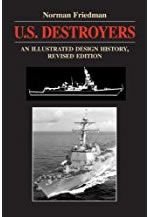USS Perkins (DD-26)
at anchor, 1918
|
|
USS Perkins (DD-26) was a Paulding class destroyer that served from Queenstown during 1917 and then off the US East Coast during 1918.
The Perkins was named after Commodore George Hamilton Perkins, a US Naval Officer during the American Civil War. She was laid down at Quincy, Mass, on 22 March 1909, launched on 9 April 1910 and commissioned on 18 November 1910.
The Perkins was the least economical of the 'Flivvers', with a range at cruising speed of 2,424nm and at 20kts of 1,470. This compared to USS Patterson, which could manage 3,919nm and 2,668nm respectively.
The Perkins had a quiet time before the American involvement in the First World War, spending some of the period in the reserve. On 28 December 1911 she was at sea with Destroyer Divisions 8 and 9 when the destroyer Warrington was hit by a schooner that cut 30 feet off her stern. This left the Warrington without power, and in need of aid. The Sterett (DD-27) arrived first, soon followed by the Walke (DD-34) and the Perkins, but it took the revenue cutter Conondaga to get a tow line onto the damaged destroyer.
The Perkins was recommissioned on 3 April 1917 just before the United States entered the war, and was quickly assigned to the Second Division, United States Destroyer Forces in Europe (alongside Paulding, Wilkes and Ammen). On 25 May she sailed as part of the Neptune (AC-8), the first ship to carry US troops across the Atlantic after the American entry into the war, operating alongside the Jarvis (DD-38) as her escort.
She was based at Queenstown from June to November 1917, performing a mix of escort duties and anti-submarine patrols. On 7 July she rescued the survivors the SS Tarquah, sunk by a torpedo, working alongside USS Cushing (DD-55). She escorted SS Bohemia from Saint Nazaire to Ireland and SS New York from Queenstown to Liverpool, demonstrating the wide area covered by the Queenstown Force.
In November 1917 she returned to the United States, where she underwent an overhaul. Between March and December 1918 she was based at Gravesend Bay, New York, and continued with a similar mix of anti-submarine patrols and escort duties. On 2 June she sighted U-151 of New Jersey but was unable to damage her. Her escort missions to her between Halifax, Nova Scotia and New York.
Anyone who served on her between 8 June and 17 November 1917 qualified for the First World War Victory Medal.
After the war she operated with the Atlantic Fleet during 1919 (including at least one visit to Cuba) and was then placed into the reserve on 5 December 1919, struck off on 8 March 1935 and sold for scrap on 28 June 1935.
Displacement (design) |
742t |
Displacement (loaded) |
887t |
Top Speed |
29.5kts design |
Engine |
3-shaft Parson turbines |
Range |
3,000nm at 16kts design |
Length |
293ft |
Width |
26ft 3in |
Armaments |
Five 3in/50 guns |
Crew complement |
86 |
Launched |
9 April 1910 |
Commissioned |
18 November 1910 |
Fate |
Sold for scrap 1935 |
 U.S. Destroyers: An Illustrated Design History, Norman Friedmann .
The standard history of the development of American destroyers, from the earliest torpedo boat destroyers to the post-war fleet, and covering the massive classes of destroyers built for both World Wars. Gives the reader a good understanding of the debates that surrounded each class of destroyer and led to their individual features.
U.S. Destroyers: An Illustrated Design History, Norman Friedmann .
The standard history of the development of American destroyers, from the earliest torpedo boat destroyers to the post-war fleet, and covering the massive classes of destroyers built for both World Wars. Gives the reader a good understanding of the debates that surrounded each class of destroyer and led to their individual features.